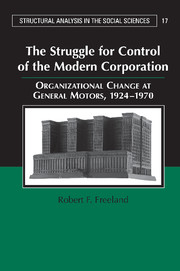 The Struggle for Control of the Modern Corporation
The Struggle for Control of the Modern Corporation Book contents
- Frontmatter
- Contents
- List of Figures and Tables
- Acknowledgments
- 1 The Modern Corporation and the Problem of Order
- 2 Creating Corporate Order: Conflicting Versions of Decentralization at GM, 1921–1933
- 3 Administrative Centralization of the M-form, 1934–1941
- 4 Participative Decentralization Redefined: Mobilizing for War Production, 1941–1945
- 5 The Split between Finance and Operations: Postwar Problems and Organization Structure, 1945–1948
- 6 Consent as an Organizational Weapon: Coalition Politics and the Destruction of Cooperation, 1948–1958
- 7 Consent Destroyed: The Decline and Fall of General Motors, 1958–1980
- 8 Conclusion
- Appendix: General Motors' Financial Performance, 1921–1987
- References
- Index
Appendix: General Motors' Financial Performance, 1921–1987
Published online by Cambridge University Press: 05 August 2011
- Frontmatter
- Contents
- List of Figures and Tables
- Acknowledgments
- 1 The Modern Corporation and the Problem of Order
- 2 Creating Corporate Order: Conflicting Versions of Decentralization at GM, 1921–1933
- 3 Administrative Centralization of the M-form, 1934–1941
- 4 Participative Decentralization Redefined: Mobilizing for War Production, 1941–1945
- 5 The Split between Finance and Operations: Postwar Problems and Organization Structure, 1945–1948
- 6 Consent as an Organizational Weapon: Coalition Politics and the Destruction of Cooperation, 1948–1958
- 7 Consent Destroyed: The Decline and Fall of General Motors, 1958–1980
- 8 Conclusion
- Appendix: General Motors' Financial Performance, 1921–1987
- References
- Index
Summary
This Appendix provides data on General Motors' financial performance between 1921 and 1987. Both organizational theorists and GM's own managers have argued that return on invested capital (ROIC) is a key indicator of financial performance. Surprisingly, however, neither GM's own public testimony on matters of profit nor scholarly analyses have attempted to calculate GM's return on investment using the methodology that the corporation developed in the mid-1920s. Published testimony and analyses usually measure “return on investment” by giving a ratio of net earnings or net profits to either gross or net assets. Such measures fail to take capital turnover into account and thus are of little use in providing a meaningful assessment of return on investment. The figures in this Appendix endeavor to adhere as closely as possible to the methodology for determining return on investment outlined by GM's Donaldson Brown.
All figures in Tables A.1 and A.2 are from General Motors' annual reports. In some cases, changes in accounting standards would cause GM to retroactively revise previously published data. In this Appendix, I have attempted to use data from the original annual report in which it was published, and usually I have not adopted subsequent revisions to those data.
From 1921 into the 1960s, the data and accounting methodology are extremely comparable. Beginning in 1962, accounts for real estate and plant began to report “unamortized special tools” as a separate entry. This had the effect of slightly lowering gross real estate and plant entries, while raising net values.
- Type
- Chapter
- Information
- The Struggle for Control of the Modern CorporationOrganizational Change at General Motors, 1924–1970, pp. 324 - 339Publisher: Cambridge University PressPrint publication year: 2000


